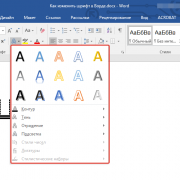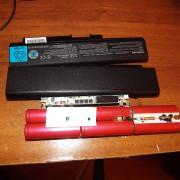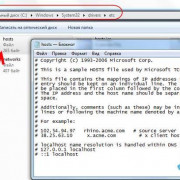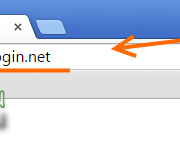SAP MM Material Management Training Tutorials
Содержание:
- SAP PP PRT Customizing Table
- SAP PP Tables for Production Orders
- SAP Order Planning tcodes
- SAP PM Main BAPI for Functional Location
- SAP MM
- SAP MM Tcodes
- SAP Material Tables SAP MM Tables
- SAP PM Functional Location
- 21 SAP PP Questions and Answers
- 1 :: Can we create Production order without bom and routing?
- 2 :: what is the difference between PP and PP-PI?Which one is better and how?
- 5 :: Explain why their is need of production version?
- 6 :: Explain what is the meaning of exploding a BOM?
- 7 :: What are all the different manufacturing scenarios in pp?
- 9 :: What is the need of pp in sap, what is the flow diagram of sap pp
- 10 :: In which context do you use bills of material? Material Requirements Planning Execute Production Goods Movements (to Help Data Entry) Product Costing Development/Engineering/Design Documentation Others?
- Управление командировками FI-TV
- Основные транзакции в SAP FI/CO.
- How to create maintenance strategy in SAP PM
- SAP PM Equipment Tables
- SAP MM Training Free SAP Material Management Module Training Tutorials
- SAP PP Tables for RoutingsOperations
SAP PP PRT Customizing Table
SAP Production Planning Table for PRT Customizing are:
| Table | Description |
|---|---|
| TCF02 | PRT categories |
| TCF03 | Texts for the production resources/tools category |
| TCF04 | Status of the PRT master |
| TCF05 | Language-dependent text table for PRT status |
| TCF06 | Field groups in the PRT master for reference |
| TCF07 | Language-dependent texts for field groups in PRT master |
| TCF08 | Assignment of PRT master fields to field groups |
| TCF10 | PRT control key |
| TCF11 | Language-dependent text table for PRT control keys |
| TCF12 | PRT group key |
| TCF13 | Language-dependent text table for PRT group keys |
You can find more details about these topics in help.sap.com.
?
Related SAP Tutorials
SAP PP Tables for Production Orders
A production order defines which material is to be processed, at which location, at what time and how much work is required. It also defines which resources are to be used and how the order costs are to be settled.
| Table | Description |
|---|---|
| AUFK | Production order headers |
| AFIH | Maintenance order header |
| AUFM | Goods movement for prod. order |
| AFKO | Order header data PP orders |
| AFPO | Order item |
| RESB | Order componenten |
| AFVC | Order operations |
| AFVV | Quantities/dates/values in the operation |
| AFVU | User fields of the operation |
| AFFL | Work order sequence |
| AFFH | PRT assignment data for the work order(routing) |
| JSTO | Status profile |
| JEST | Object status |
| AFRU | Order completion confirmations |
SAP Order Planning tcodes
For Order Planning in SAP PP ,the main Transaction Codes are:
| SAP Order Planning tcodes | Description |
|---|---|
| OPL8 | Order type parameters: Overview |
| OPK4 | Confirmation Parameters |
| OPJJ | Maintain Scope of Check |
| OPJK | Maintain Control |
| OPKP | Shop floor control profile |
| OPJH | Order types production order |
| OPK8 | Maintain print control prod. orders |
| OPK0 | Confirmation Parameters PP |
| OPJ2 | Production order stock determination |
| OPJB | Specify system messages |
| OPJG | Maintain Default Values |
| OPJ8 | Maintain Operation Control Key |
| OPJF | Automatic Selection |
| OPKA | Maintain Movement Types |
| OPLE | Strategy types: Batch determ. (prod) |
SAP PM Main BAPI for Functional Location
Functional Location in SAP PM can be handled by the following SAP BAPI :
| BAPI | Description |
|---|---|
| BAPI_FUNCLOC_CHANGE | Change Functional Location |
| BAPI_FUNCLOC_CREATE | Create Functional Location |
| BAPI_FUNCLOC_GETDETAIL | Read Functional Location |
| BAPI_FUNCLOC_GETLIST | Read List of Functional Locations (with Internal Key) |
| BAPI_FUNCLOC_GETSTATUS | Read (System-/User-) Status of Functional Location |
| BAPI_FUNCLOC_SET_LABEL_SYSTEM | User-Dependent Setting of Current System Indicator |
| IDOC_INPUT_FUNC_LOC_CHANGE | |
| IDOC_INPUT_FUNC_LOC_CREATE |
Check also
- SAP PM Equipment Creation Explained – General Data (1)
- SAP PM Main Tcodes: Most used and classified by Topics
- List of SAP PM Main Tables ( Plant Maintenance ) grouped by PM Topics
SAP MM
SAP MM Material Management Training Tutorials for free of cost by SAP MM experts. SAP MM training material is designed to configure the SAP MM module in an easy way step-by-step.
SAP MM ( Material Management ) is one of the important modules in SAP ERP software and MM application module supports the procurement and inventory functions occurring in day-to-day business operations. This MM module contains many aspects such as purchasing, goods receiving, material storage, consumption-based planning, and inventory. SAP MM is integrated with other SAP modules such as Finance (FI), Controlling (CO), Sales and Distribution (SD), Quality Management (QM), Plant Maintenance (PM), Production Planning (PP), and Warehouse Management(WM).

SAP Tutorials
SAP MM training tutorials provides you everything implementation and end user level process step-by-step with screen shots. Support for your new job and projects
Please refer below SAP MM module course one by one in series.
SAP Enterprise Struture
- Define Company
- Define Company Code
- Assign Company Code to Company
- Define Plant
- Assign Plant to Company Code
- Maintain Storage Locations
- Maintain Purchase Organisation
- Create Purchasing groups
- Assign Purchasing Organization to Company Code
- Assign purchasing organisation to reference purchasing organisation
- Assign Purchase Organization to Plant
MM Master Data
- Split Valuation configuration
- Create Material Group in SAP MM
- Create Material Types in SAP MM
- Define Industry Sectors
- Maintain company codes for material management
- Define MRP Controllers
- Create, Change, Display Material
- Create purchasing info records
Vendor Master
- Define vendor account groups
- Maintain number ranges for vendor accounts
- Assign number ranges to vendor accounts
- create sundry credit account
- Tolerance group for vendors
- Vendor payment terms
- Create vendor master data
- Automatic payment program configuration
- Interest calculation configuration
Procurement
- Procurement Process Cycle Overview
- Types of Purchasing Documents
- Set Tolerance Limits for Price Variance
- Maintain source list
- Create Purchase Requisition (PR)
- Create Request for Quotation (RFQ)
- Maintain Quotations
- Create Purchase Order for stock materials
Inventory Management
- Create Movement Types
- Goods Receipt Invoice (GRIN)
- Post goods issue
- Stock transfer and Transfer posting
>> Check Sap Interview Questions & Answers >>
SAP MM Tcodes
Within the most important Transactions Code in SAP MM (Material Management), we can list
| SAP MM TCODES | DESCRIPTION |
|---|---|
| AC02 | Service Master |
| MB01 | Post Goods Receipt for Purchase Order |
| MB1A | Goods Withdrawal |
| MB1B | Transfer Posting |
| MB1C | Post Other Goods Receipts |
| MB21 | Create Reservation |
| MB51 | Material Document List |
| MB52 | List of Warehouse Stocks on Hand |
| MB5T | Stock in Transit |
| MBST | Cancel Material Document |
| ME01 | Maintain Source List |
| ME11 | Maintain Purchasing Info Record |
| ME21N | Create Purchase Order |
| ME22N | Change Purchase Order |
| ME23N | Display Purchase Order |
| ME29N | Release Purchase Order |
| ME31L | Create Scheduling Agreement |
| ME32L | Change Scheduling Agreement |
| ME33L | Display Scheduling Agreement |
| ME41 | Create RFQ/Quotation |
| ME42 | Change RFQ/Quotation |
| ME43 | Display RFQ/Quotation |
| ME51N | Create Purchase Requisition |
| ME52N | Change Purchase Requisition |
| ME53N | Display Purchase Requisition |
| ME59N | Automatic generation of Purchase Order |
| MEQ1 | Create Quota Arrangement |
| MEQ2 | Change Quota Arrangement |
| MEQ3 | Display Quota Arrangement |
| MIGO | Post Goods Movement |
| MIR5 | Display List of Invoice Documents |
| MIR6 | Invoice Overview |
| MIR7 | Park Invoice |
| MIRA | Fast Invoice Entry |
| MIRO | Enter Incoming Invoice |
| ML33 | Create Vendor Conditions |
| ML81N | Create Service Entry Sheet |
| MM01 | Create Material |
| MM02 | Change Material |
| MM03 | Display Material |
| MMB1 | Create Semi Finished Product |
| MMBE | Stock Overview |
| MMDE | Delete All Materials |
| MMF1 | Create Finished Product |
| MMG1 | Create Returnable Packaging |
| MMH1 | Create Trading Goods |
| MMI1 | Create Operating Supplies |
| MMK1 | Create Configurable Material |
| MMN1 | Create Non-Stock Material |
| MMNR | Define Material Master Number Ranges |
| MR8M | Cancel Invoice Document |
| MRBR | Release Blocked Invoices |
| MRIS | Settle Invoicing Plan |
| MRRL | Evaluated Receipt Settlement |
| OME4 | Create Purchasing Group |
| OMJJ | Customizing: Define New Movement Types |
| OMR6 | Tolerance limits: Invoice Verification |
| OX01 | Assign Purchasing Organization to Company Code |
| OX02 | Create Company Code |
| OX08 | Create Purchasing Organization |
| OX09 | Create Storage Location |
| OX10 | Create Plant |
| OX15 | Create Company |
| OX17 | Assign Purchasing Organization to Plant |
| OX18 | Assign Plant to Company Code |
| XK01 | Create Vendor |
| XK02 | Change Vendor |
| XK03 | Display Vendor |
Check also SAP MMBE: SAP Stock Overview MMBE Tcode
SAP Material Tables SAP MM Tables
The main SAP MM Tables for Material Management in SAP are:
SAP MM Tables for Purchasing
Regarding to Purchasing in SAP Material Management, the most important tables for Purchasing are:
| SAP MM TABLE | DESCRIPTION |
|---|---|
| EBAN | Purchase Requisition |
| EBKN | Purchase Requisition Account Assignment |
| EINA | Purchasing Info Record- General Data |
| EINE | Purchasing Info Record- Purchasing Organization Data |
| EIPA | Order price history record |
| EKAB | Release Documentation |
| EKBE | History per Purchasing Document |
| EKBZ | Purchasing document history: delivery costs |
| EKET | Scheduling Agreement Schedule Lines |
| EKKN | Account Assignment in Purchasing Document |
| EKKO | Purchasing Document Header |
| EKPB | Material to be provided item in purchasing document |
| EKPO | Purchasing Document Item |
| EKUB | Index for Stock Transport Orders for Material |
| EORD | Purchasing Source List |
| ESKN | Account assignment in service package |
| ESLH | Service package header data |
| ESLL | Lines in service package |
| ESSR | Service entry sheet header data |
| ESUC | External services management: Unplanned limits for contract item |
| ESUH | External services management: unplanned service limits header data |
| ESUP | External services management: unplanned limits for service packages |
| ESUS | External services management: Unplanned limits for service types |
SAP MM Tables for Inventory Management
The main Inventory Management Tables for SAP MM are:
| SAP MM TABLE | DESCRIPTION |
|---|---|
| IKPF | Header- Physical Inventory Document |
| ISEG | Physical Inventory Document Items |
SAP MMBE : SAP Stock Overview MMBE Tcode
For SAP Stock Overview Tcodes, you have Vendor, Dunning, Bank and Transactions details.
The most important SAP MMBE SAP Stock Overview MMBE Tcode are:
| SAP MM TABLE | DESCRIPTION |
|---|---|
| LFA1 | Vendor General Data |
| LFAS | VAT registration numbers general section |
| LFB1 | Vendor + Company |
| LFB5 | Dunning data |
| LFBK | Bank details |
| LFC1 | Transaction figures |
| LFC3 | Special G/L transaction figures |
| LFM1 | Vendor master record purchasing organization data |
| LFM2 | Vendor Master Record: Purchasing Data |
SAP MM Tables fro Material Master
Material Master Data are stored in the following SAP MM tables
| SAP MM TABLE | DESCRIPTION |
|---|---|
| MAKT | Material Descriptions |
| MAPR | Material Index for Forecast |
| MARA | General Material Data |
| MARC | Plant Data for Material |
| MARD | Storage Location Data for Material |
| MARM | Units of Measure for Material |
| MAST | Material to BOM Link |
| MBEW | Material Valuation |
| MCHA | Batches |
| MCHB | Batch Stocks |
| MDBS | Material View of Order Item/Schedule Line (good to find open PO’s) |
| MKOL | Special Stocks from Vendor |
| MKPF | Header- Material Document |
| MLAN | Tax Classification for Material |
| MLGN | Material Data for Each Warehouse Number |
| MLGT | Material Data for Each Storage Type |
| MOFF | Lists what views have not been created |
| MSEG | Document Segment- Material |
| MSKA | Sales Order Stock |
| MVER | Material Consumption |
| MVKE | Sales Data for materials |
SAP MM Tables for Invoice Verification
For Invoice Verification, check the following SAP MM Tables:
| SAP MM TABLE | DESCRIPTION |
|---|---|
| MYMFT | FIFO results table |
| MYML | LIFO material layer |
| MYMLM | LIFO material layer (monthly) |
| MYMP | LIFO period stocks & single material |
| MYMP1 | Receipt data LIFO/FIFO valuation |
| MYPL | LIFO pool layer |
| MYPLM | LIFO pool layer (monthly) |
| RBCO | Document item incoming invoice account assignment |
| RBDIFFKO | Invoice Verification: conditions |
| RBDIFFME | Invoice Verification: quantity differences |
| RBDRSEG | Invoice Verification batch: invoice document items |
| RBKP | Document header: incoming invoice |
| RESB | Reservation/dependent requirements |
| RKPF | Document Header- Reservation |
Check also
- The Most Important SAP Stocks Tables used in SAP MM/SD
- SAP KNVV: Customer Master Sales Data
- MVKE Table in SAP MM (Material Sales Data Table)
SAP PM Functional Location
Master Record for Functional Location
The master record for the functional location uses the following views:
1), General: Class, object type, reference data, and manufacturer data.
2), Location: Location data, address
3), Organization: Account assignment (for example, company code, cost center), responsibilities (for example, maintenance planning plant)
4), Structure: For example, structure indicator, higher-level functional location, equipment
Additional data or links in the master record for the functional location can also be activated as tab pages or called up using push buttons (see graphic).
Also See: SAP Implementation available Tools During the Project
21 SAP PP Questions and Answers
1 :: Can we create Production order without bom and routing?
yes we can create a production order without BOM & routing.
Change the Config in OPL8 ( order type dependent parameters)
as routing optional. But it may ask for a sales order when
we try to create order using CO01
Is This Answer Correct?149 Yes4 No
Post Your Answer
2 :: what is the difference between PP and PP-PI?Which one is better and how?
PP—> Prodction Planning mostly used for descrete type of
industries , where at the time of confirmation the output is
sure to be fixed. eg Automobile
PP- PI—> Production Planning for Process Industries , here
mostly used for the typical chemical industries , as the
Yield is not fixed due to chemical reaction yield values can
be varied to noticable extent. Eg X+Y =Z some 10 kg of X
and 1 KG of Y givs yiled that is Z of 10 Kg only.
Is This Answer Correct?78 Yes1 No
Post Your Answer
5 :: Explain why their is need of production version?
In production version, we assign the BOM and ROUTING
combination. And in case of alternate BOMs , it clears which
alternative bom has to be selected automatically.
Is This Answer Correct?62 Yes3 No
Post Your Answer
6 :: Explain what is the meaning of exploding a BOM?
it is the process of multiplying the requirement by the
usage quantity and recording the appropriate requirements
throughout the product tree
Is This Answer Correct?42 Yes3 No
Post Your Answer
7 :: What are all the different manufacturing scenarios in pp?
There are different scenarios in SAP PP module.
1)Make to stock
2)Make to order
3)External processing (Subcontracting)
4)Rework processing
5)Prodcution in another plant
Is This Answer Correct?53 Yes4 No
Post Your Answer
9 :: What is the need of pp in sap, what is the flow diagram of sap pp
SAP pp provides capabilities for planning, execution,
quality, maintenance.This integrated manufacturing solution
gives you the features and functions necessary for you to
handle:
Activity flow
Step 1. Material Creation-Finished with suitable material
type.
Step 2. Purchasing and procurement of Material
Step 3. Creation of Bills of Material
Step 4. Creation of Work center
Step 5. Creation of routing.
Step 6. Creation of Production Order
Step 7. Confirmation of production order
Step 8. Stock check
Step 9. MRP run
Step 10.Material Procurement
Is This Answer Correct?39 Yes3 No
Post Your Answer
10 :: In which context do you use bills of material? Material Requirements Planning Execute Production Goods Movements (to Help Data Entry) Product Costing Development/Engineering/Design Documentation Others?
Управление командировками FI-TV
|
Код транзакции |
Описание транзакции |
|
PR05 |
Менеджер по командировочным расходам |
|
PR02 |
Календарь командировок |
|
PREC |
Массовый расчет командировок |
|
TRIP |
Менеджер по командировкам |
|
SWIA |
Обработка потока операций |
|
PRTE |
Подробная информация о командировке |
|
PRRW |
Обработка прогона проводок |
|
HRUUTRV0 |
Создание приказов по персоналу для командировок |
Основные транзакции в SAP FI/CO.
|
Код транзакции |
Описание транзакции |
|
|
FK01 |
Создание кредитора |
|
|
FK02 |
Изменение кредитора |
|
|
FK03 |
Просмотр кредитора |
|
|
FBL1N |
Список позиций кредиторов |
|
|
FD01 |
Создание дебитора |
|
|
FD02 |
Изменение дебитора |
|
|
FD03 |
Просмотр основных данных дебиторов |
|
|
FD32 |
Обновление лимита кредитования |
|
|
FBL5N |
Список позиций дебиторов |
|
|
S_ALR_87012178 |
Анализ открытых позиций дебитора по просроченным сальдо |
|
|
FD10N |
Просмотр сальдо |
|
|
RFMAHN20 (Отчет) |
История напоминаний |
|
|
FS02 |
Изменение Основного счета |
|
|
KA03 |
Просмотра вида затрат |
|
|
KA02 |
Изменение вида затрат |
|
|
KA01 |
Создание вида затрат |
|
|
KA06 |
Создание вторичного вида затрат |
|
|
KA04 |
Удаление вида затрат |
|
|
FAGLL03 |
Просмотр отдельных позиций основных счетов (новая Главная книга) |
|
|
FBL3N |
Просмотр отдельных позиций основных счетов |
|
|
FS10N |
Анализ основных счетов |
|
|
FAGLB03 (Новая Главная книга) |
Просмотр сальдо |
|
|
S_ALR_87012277 |
Сальдо основных счетов |
|
|
S_PL0_86000032 |
Структурированная оборотная ведомость |
|
|
FB02 |
Изменение документа |
|
|
FB03 |
Просмотр документа |
|
|
AS01 |
Создание основного средства |
|
|
AS02 |
Изменение основного средства |
|
|
AS03 |
Просмотр основного средства |
|
|
AW01N |
Проводник Учета основных средств |
|
|
S_ALR_87011966 |
Запасы по местам возникновения затрат |
|
|
KS01 |
Создание места возникновения затрат |
|
|
KS02 |
Изменение места возникновения затрат |
|
|
KS03 |
Просмотр места возникновения затрат |
|
|
KO01 |
Создание внутреннего заказа |
|
|
KO02 |
Обработка внутреннего заказа |
|
|
KO03 |
Просмотр внутреннего заказа |
|
|
KE51 |
Создание места возникновения прибыли |
|
|
KE52 |
Изменение места возникновения прибыли |
|
|
KE53 |
Просмотр места возникновения прибыли |
|
|
KB11N |
Ввод ручного переноса первичных затрат |
|
|
KB13N |
Просмотр ручного переноса первичных затрат |
|
|
KB14N |
Сторнирование ручного переноса первичных затрат |
|
|
CK13N |
Просмотр калькуляции |
|
|
CO03 |
Просмотр продуктивного заказа |
|
|
COR3 |
Просмотр технологического заказа |
|
|
MM03 |
Просмотр материала |
|
|
FB09D |
Просмотр отдельных позиций |
|
|
XD02 |
Изменение дебитора (централизованно) |
|
|
XK02 |
Изменение кредитора (централизованно) |
|
|
FBICR1 |
Открытые позиции Главной книги: выверка документов |
|
|
FBICR2 |
Открытые позиции Главной книги: выверка документов |
|
|
FBICR3 |
Дебитор/кредитор: выверка документов |
|
|
CK40N |
Просмотр прогона калькуляции |
How to create maintenance strategy in SAP PM
In this activity you create maintenance strategy in SAP to define the frequency of specific work packages for a type of equipment. Work package can be a inspection, maintenance, service, etc. Each of this work packages consists the different frequencies.
Navigation
You can define maintenance strategy in SAP PM by using the following navigation method.
| Transaction code | IP11 |
| SAP Menu Path | Logistics > Plant Maintenance> Preventive Maintenance > Maintenance planning > Maintenance strategies > change. |
Configuration steps
Perform the following configuration steps to create maintenance strategy in SAP Plant Maintenance module.
Step 1 : Execute t-code “IP11” in command field from SAP easy access screen.
Step 2 : On change view maintain strategies overview screen, choose maintenance strategies folder under dialog structure and click on new entries button to create the new maintenance strategy in SAP.

Step 3 : On change maintenance strategies details screen, update the following details.
- Name : Enter the alpha numeric key that defines as strategy in SAP.
- Description : Update the descriptive text of maintenance strategy i.e. Electric pumps perf. based H.
- Scheduling indicator : Choose the appropriate unit, i.e. time.
- Strategy unit : It defines as unit of time, choose Mon (month) or Yr (year).
- Call horizon : In most cases 100% is used for call horizon. When an order is generated before a call is required, it is expressed as percentage of cycle length.
- Shift factor for late completion : It is used to determine the impact of late completion of work. Update the percentage for late completion
- Tolerance for late completion (%) : Update percentage of tolerance for late completion
- Shift factor for early completion :It is used to determine the impact of early work completion, enter the percentage factor for early completion.
- Tolerance for early completion (%) : Update the percentage of tolerance limit for early completion.
- Factory Calendar : Leave this field as blank or choose the factory calendar as per requirements.
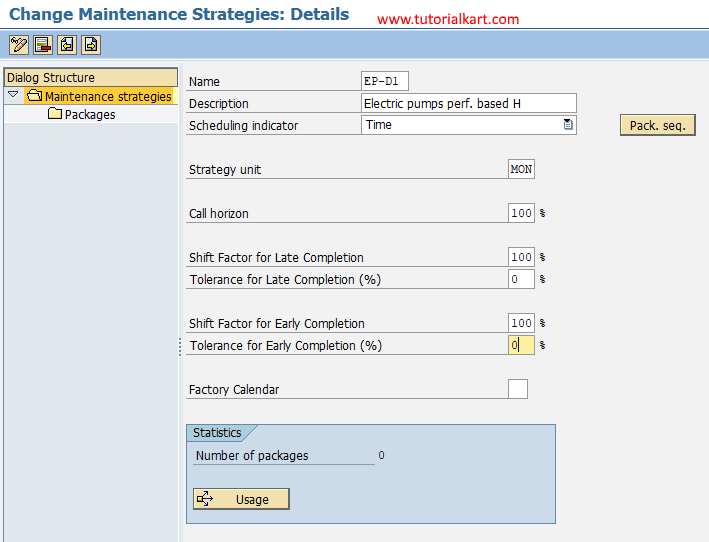 Now choose save icon and save the configured details.
Now choose save icon and save the configured details.
Step 4 : Choose the maintenance strategies key and click on packages folder.
Step 5 : Click on new entries button and update the following details.
- Package no : Update the sequential identifying number of cycle item, starting at 1.
- Cycle length : Frequency of inspection or maintenance period.
- Unit : Unit for performance of maintenance task.
- Maintenance cycle text : Descriptive text of work.
- Cycle short text : Update the two characteristic key as cycle short text and it is used for assigning to task list.
- Hierarchy : Enter the hierarchy level of maintenance package.
- Hierarchy shot text : Short text of hierarchy.
 Choose save icon and save the configured maintenance packages details
Choose save icon and save the configured maintenance packages details
Successfully we have created maintenance strategy in SAP PM.
Download SAP PM — Create Maintenance Strategy in SAP in PDF
SAP PM Equipment Tables
The business object “Equipment” is an individual, physical object that is to be maintained independently.
It can be installed in a technical system or part of a technical system.
The main SAP Plant Maintenance Tables for Equipment are:
| PM EQUIPMENT TABLE | DESCRIPTION |
|---|---|
| EQUI | Equipment master data |
| EQKT | Multilingual equipment short texts long texts and internal remarks |
| EQUZ | Equipment time segments |
| ILOA | Location and account assignment data for the maintenance object |
| IHSG | Table of permits for Plant Maintenance with long texts |
| IHPA | Partners |
| FLEET | Fleet object-specific data for technical objects |
SAP MM Training Free SAP Material Management Module Training Tutorials
SAP MM Course Summary
In SAP R/3 system, SAP MM module is one important module of logistics that deals with procurement process of an organization. This MM module is mainly focus on inventory management, Warehouse management, Vendor master data and purchasing. SAP Material Management module can be integrated with other modules of SAP like SAP FICO, SAP SD, SAP QM, SAP WM and with various modules based on the requirements of an organization.
Prerequisites: What should I know?
This SAP MM course is completely designed from basic concepts of SAP, so no background knowledge is required to learn SAP MM module.
SAP MM Training Syllabus
Below SAP MM tutorials are designed from basic concepts to advanced concepts. Beginners can easily learn MM module step by step with real time scenarios through this free SAP MM training.
SAP MM Training – Organization Structure
- Tutorial – How to create company code in SAP
- Tutorial – How to assign company code to company in SAP
- Tutorial – How to create plant in SAP
- Tutorial – How to assign plant to company code in SAP
- Tutorial – How to create storage location in SAP
- Tutorial – How to create purchase organization in SAP
- Tutorial – How to assign purchase organization to company code
- Tutorial – How to assign purchase organization to plant in SAP
- Tutorial – How to assign standard purchase organization to plant
SAP MM Training- Master Data
- Tutorial – An overview of material master
- Tutorial – How to define attributes for material types
- Tutorial – How to define number range interval for material type
- Tutorial – How to define material groups
- Tutorial – How to define company code for material management
- Tutorial – How to create material master data
- Tutorial – How to define purchase information record
- Tutorial – How to create vendor account groups
- Tutorial – How to define number ranges for vendor accounts
- Tutorial – How to assign number ranges to vendor account groups
- Tutorial – How to maintain terms of payment in SAP
- Tutorial – How to maintain plant parameters for MRP
SAP MM Training- Purchasing
- Tutorial – Define number ranges for purchase requisition
- Tutorial – How to define document types for PR
- Tutorial – How to define processing time
- Tutorial – How to define screen layout at document level
- Tutorial – How to define text types
- Tutorial – How to define number rages for RFQ
- Tutorial – How to define document types for RFQ
- Tutorial – How to maintain quotation comments
- Tutorial – How to define text types for Header texts
- Tutorial – How to define text types for item texts
- Tutorial – How to define number ranges for PO
- Tutorial – How to define document types for PO
- Tutorial – How to set tolerance limits for price variance
- Tutorial – How to define texts for purchase order
- Tutorial – How to edit characteristics for PO
- Tutorial – How to Edit class for PO
- Tutorial – How to define release procedure for PO
- Tutorial – How to define access sequence
- Tutorial – How to define condition type for purchasing.
Download SAP MM Training — Learn SAP MM Module in PDF
SAP PP Tables for RoutingsOperations
The routing lists the operations needed to manufacture a product. It specifies the following for each operation:
- The work center at which the operation is carried out
- Which default values are to be used to calculate the dates, capacities, and production costs
- Whether the costs of an operation are taken into account for costing
- The material components needed to carry out an operation
In repetitive manufacturing, you can use rate routings in addition to normal routings and reference operation sets.
SAP PP Master Data Tables
| Table | Description |
|---|---|
| MAPL | Allocation of task lists to materials |
| PLAS | Task list : selection of operations/activities |
| PLFH | Task list :production resources/tools |
| PLFL | Task list : sequences |
| PLKO | Task list :header |
| PLKZ | Task list: main header |
| PLPH | Phases / suboperations |
| PLPO | Task list operation / activity |
| PLPR | Log collector for tasklists |
| PLMZ | Allocation of BOM :items to operations |
Check alos?How to Link Between PLKO and PLPO for Routine in SAP

